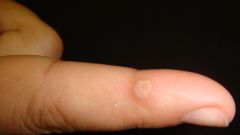What is warts?
Warts – the outward manifestation of disease of the skin caused by human papilloma virus. They are considered benign tumors, although they can sometimes develop into a malignant tumor. These seals appear at any age, but most often in adolescents.
The appearance of warts are varied. It depends on the location on the body and how much she is injured.
To warts can appear at any place both single and groups. There are times that they are completely disappear without any medical treatment, but there is a possibility of their return and even spread to other skin areas.
There are six types of warts. Most often they are simple. This is a benign solid tumors that have clear borders and any form. Their color varies from light yellow to grayish black.
There are also plantar warts. Due to the constant pressure they become more dense and are covered by keratinized epithelium. If you cut the top of this seal, there will be a drop of blood. This is what distinguishes them from calluses and corns.
Flat warts – flat, smooth nodules, which are formed usually on the face in the area of scratching. Most often they occur at a young age.
Condylomas, or genital warts are the soft, moist bubbles of pink. They occur in warm and moist areas of the body, for example, the external genitals.
There are still warts with unusual shapes, for example sitting on the stem. They are formed on the neck and the head, especially on the hairy part.
What professionals need to address?
If you find yourself not the body of the wart, the first thing you need to contact a dermatologist. He will elaborate on the kind of wart and if the case is easy, will appoint treatment. But some types of entities can become cancerous because they are influenced by mechanical factors, such as irritation or friction. Then the doctor will refer you to a skin oncologist.
The skin oncologist will examine the pathological elements, and take from them a tissue biopsy, that will allow the specialist to determine the type of wart and to exclude the presence of a malignant tumor. If the formation is malignant, the doctor will prescribe appropriate treatment. He can also give advice on how to remove warts and to prescribe the appropriate method.
In some cases, it may require the help of a surgeon. He surgically removes the warts, and explains how to care for the wound, to avoid complications such as bleeding or nahravanie.
In very rare cases, you may need the assistance of other specialists. For example, if after removal of warts joined by an infection, then you need to consult a therapist or physician-infectious disease. The appearance of pus to come to the reception to the surgeon. Also, the doctor can remove scars that Mar the appearance of the skin.


